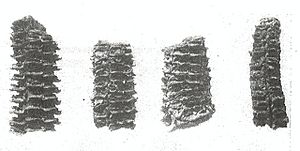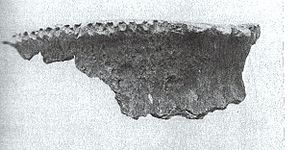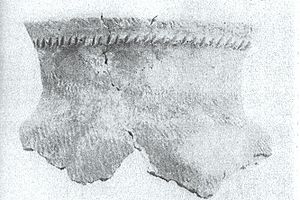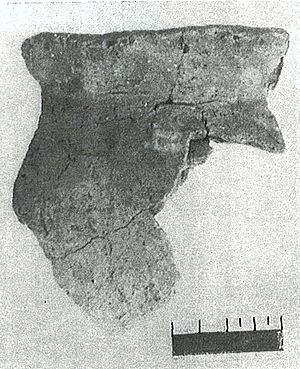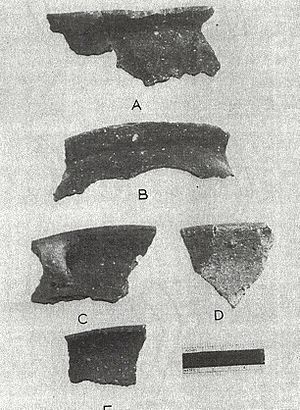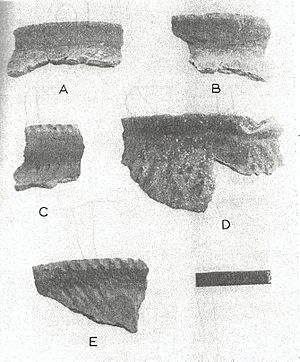Moccasin Bluff site facts for kids
Quick facts for kids |
|
|
Moccasin Bluff site
|
|
 |
|
| Location | Red Bud Trail near Buchanan, Michigan |
|---|---|
| Area | 5 acres (2.0 ha) |
| NRHP reference No. | 77000710 |
| Added to NRHP | April 13, 1977 |
The Moccasin Bluff site (also known as 20BE8) is an archaeological site in Michigan. It is located along the Red Bud Trail and the St. Joseph River, north of Buchanan, Michigan. This important site was added to the National Register of Historic Places in 1977.
Archaeologists have found evidence that people lived here during many different time periods. The most important findings are from the Late Woodland and Upper Mississippian times.
Contents
- Exploring the Past: History of Moccasin Bluff
- What the Moccasin Bluff Site Looks Like
- Discoveries from 1948 Excavations
- Discoveries from 2002 Excavations
- How People Lived at Moccasin Bluff
- Images for kids
Exploring the Past: History of Moccasin Bluff
The land near Moccasin Bluff and the St. Joseph River was used by people as early as 6300 BC. These early groups set up temporary camps here.
Around 500 AD, the people living at Moccasin Bluff traded with other Native American groups. These groups came from places like Illinois and Indiana. By 1100-1400 AD, people started building more permanent villages. They also began farming the land.
In the late 1820s, European settlers moved into this area. They came to cut down trees and farm the land. The U.S. government then decided to move the local Potawatomi people further west. The bluff is said to be named after Cogomoccasin, a leader of one of these Potawatomi villages.
In 1948, a team from the University of Michigan dug at the site. They found pottery, burials, and remains of maize (corn) and storage pits. Later, in 2002, Michigan State University explored a wetland area nearby. This area had not been studied before.
What the Moccasin Bluff Site Looks Like
The Moccasin Bluff site sits on a flat area of land called a terrace. This terrace is next to the Red Bud Trail. From here, you can see a wide bend in the St. Joseph River with two islands. Hills protect the site in a half-circle to the north, west, and south.
This site is very important because it shows that people lived here for a very long time. It is one of the few places in western Michigan with so much evidence of ancient life. Because of this long history, the site has a rich midden. A midden is like an ancient trash pile, full of artifacts.
The layers of soil at the site are mixed, but the artifacts themselves tell a story. Scientists use radiocarbon dating to figure out how old the items are. They also compare them to findings from other sites. This helps them understand different periods of Native American history, from about 8500 BC to the 1600s AD. This was just before Europeans arrived.
Evidence from the Archaic (c. 8500–1500 BC), Early Woodland (c. 1500-100 BC), and Middle Woodland (c. 100 BC–500 AD) periods has been found. However, most of the activity happened during the Late Woodland period (c. 500–1500 AD). There is also evidence of the Upper Mississippian (c. 1000–1500 AD) culture.
Discoveries from 1948 Excavations
The digs in 1948 uncovered many interesting things. Researchers found ancient pits, artifacts, animal bones, and plant remains.
Ancient Features Found
Archaeologists did not find any signs of dwellings (houses) or post molds (holes where posts for structures would have been). They believe that the main part of the site, where houses might have been, was destroyed when the Red Bud Trail Highway was built.
They did find four types of pits:
- Storage pits (62 of them) were used to store food.
- Fire pits (17 of them) were used for cooking.
- Hearths (19 of them) were also used for fires.
- Smudge pits (2 of them) were used for special purposes.
Three burials were also found, but only one was fully dug up.
The fire pits might have been like earth ovens. They could have been used to roast white water lily tubers (roots). No tubers were found here, but they were found in similar pits at other sites.
Both smudge pits contained burned maize (corn). Scientists think these pits were used to create smoke to cure animal hides.
Animal Bones: What People Ate
The bones of 32 different animal species were found at Moccasin Bluff. When scientists looked at how much meat each animal provided, they found:
Most of these bones were likely food remains. The dog and bear bones might also be from special ceremonial or religious activities. Some Native American tribes had ceremonies involving dog sacrifice or bear worship.
Plant Remains: Ancient Foods and Forests
Scientists studied wood charcoal from the fire pits. They found it was mostly oak, hickory, and maple. This shows what the local deciduous forest was like back then.
Some burned food remains were also found. These included acorns, walnuts, Canadian plums, butternuts, and hickory nuts. The two smudge pits contained Eastern Complex maize (corn).
Tools and Treasures: Artifacts
Many different artifacts were found at the site. These items help us understand daily life, ceremonies, and even what people wore.
- Pottery: No complete pots were found. However, 534 pieces of pot rims and other distinct pieces were analyzed. These came from at least 424 different pots.
- Stone Tools: Over 1,500 stone tools, tool pieces, and flakes were found. These included hammer stones, anvil stones, celts (like axes), and grinding stones.
- Bone Tools: Tools made from bone were also present. These included bone cylinders, tools for working hides, antler tools, bone awls (for piercing), elk scapula (shoulder blade) tools, and turtle carapaces (shells). A piece of a bone rasp (a musical instrument) was also found.
- Stone Pendants: Two pieces of stone with holes were found. They were likely used as pendants.
- Pipes: Six pieces of pipes or unfinished pipe bowls were found. They were made from clay or stone.
- Red Ochre: Seven pieces of red ochre were found. This red pigment was often used for art or ceremonies.
Here are some interesting non-pottery artifacts found:
| Material | Description | Image | Use |
|---|---|---|---|
| Chipped stone | Small Triangular points (like arrowheads) | 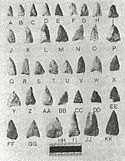 |
Used for hunting, fishing, or warfare. They were likely tips for bows-and-arrows. |
| Chipped stone | Bifacially flaked end scraper |  |
Used for processing wood or animal hides. |
| Chipped stone | Drills (T-shaped shown) |  |
Used for drilling holes in wood or hides. |
| Bone | Perforated deer bone |  |
Possibly used as a pendant or for personal decoration. |
| Bone | Elk scapula hoes | 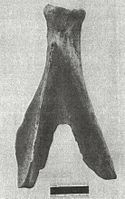 |
Used for farming, gardening, or general digging. |
| Bone | Bone rasp (musical instrument) |  |
Used for entertainment or in ceremonies. |
| Bone | Grooved bone |  |
Its exact use is unknown. |
| Bone | Unmodified deer mandibles (jawbones) | Likely used for scraping maize kernels off the cobs. Their large number suggests this. | |
| Stone | Pipe bowl fragments | Used for smoking pipes, possibly for recreation or ceremonies. |
Pottery Types and Time Periods
Archaeologists find pottery very helpful for understanding ancient cultures. Pottery is often found in large amounts, and its style and decoration can tell us about the time period, location, and culture of the people who made it.
Middle Woodland Period Pottery (c. 100 BC–500 AD)
About 20 pieces of Havana Ware pottery were found. The Havana Culture was a local style of the Middle Woodland period. During this time, cultures like the Adena and Hopewell were important in the Mississippi and Ohio River Valleys. Middle Woodland cultures built large burial mounds, had special ceremonial practices, farmed, and traded widely.
Late Woodland and Upper Mississippian Pottery (c. 500 AD–1500 AD)
The Late Woodland period in the Great Lakes region saw the start of maize (corn) farming. This led to more food and more people. More people sometimes meant more competition and conflict. After 1000 AD, cultures from the Mississippian areas further south influenced the Great Lakes area. This led to the creation of Upper Mississippian cultures.
From the 1948 digs, two main types of pottery were identified from this period:
- Moccasin Bluff Ware: This pottery used grit (small stones) for tempering (strengthening the clay). There were 327 vessels of this type.
- Berrien Ware: This pottery used crushed shell for tempering. There were 48 vessels of this type.
Moccasin Bluff Ware
Moccasin Bluff ware has several different styles. Some examples include:
- Moccasin Bluff cordmarked: This pottery has a surface that looks like it was pressed with cords.
- Moccasin Bluff collared: This pottery has a thickened rim, sometimes with raised points.
- Moccasin Bluff plain modified lip: This pottery has smooth surfaces with special notches or finger marks on the rim. Similar pottery has been found at sites linked to the Potawatomi people. This type might be from the very late prehistoric period or early historic times.
- Moccasin Bluff notched applique strip: This pottery has a thickened rim with designs added on a strip of clay. This type is also from the late prehistoric or early historic period.
- Moccasin Bluff scalloped: This pottery has a wavy or scalloped rim edge. This type has also been found at other sites in western Michigan and might be linked to the Potawatomi.
Berrien Ware
Berrien ware used shell for tempering. It is linked to two Upper Mississippian cultures:
- Huber Ware: This pottery has a smooth surface and is often plain. Sometimes it has lines carved into the shoulder area. Huber culture was centered around the Chicago area. It is thought to be from the late prehistoric to early historic period (around 1400-1650 AD). Some Huber sites have even found European trade goods. The Miami tribe might be linked to this pottery. Small "toy" pots were also found, possibly made by children learning pottery.
- Fisher Ware: This pottery often has a cordmarked surface and carved designs. It is thought to be a bit older than Huber ware. Fisher and Huber cultures sometimes lived in the same areas.
Timeline of Late Prehistoric Cultures
The large amount of pottery found at Moccasin Bluff helped researchers create a timeline for Late Woodland cultures in western Michigan and northwest Indiana.
| Phase | Date range | Main Pottery Types |
|---|---|---|
| Brems phase | c. 500–1050 A.D. | Moccasin Bluff modified lip and Moccasin Bluff collared |
| Moccasin Bluff phase | c. 1050–1400 A.D. | Moccasin Bluff impressed exterior lip, Berrien Ware (Fisher ware) |
| Berrien phase | c. 1400–1650 A.D. | Berrien ware (Huber ware), Moccasin Bluff plain modified lip, Moccasin Bluff notched applique strip, and Moccasin Bluff scalloped. This phase has been dated by radiocarbon dates of 1590 AD and 1640 AD. |
The Berrien phase ends when prehistory meets the historic period. Researchers think that Berrien–Huber ware might be linked to the historic Miami tribe. Moccasin Bluff Scalloped pottery might be linked to an Algonquian-speaking tribe like the Potawatomi.
It's important that no European trade goods were found in the Berrien phase at Moccasin Bluff. This means the site was likely abandoned just before Europeans arrived. This might be because the Potawatomi were forced to move from western Michigan during the Iroquois Wars. They moved to the west shore of Lake Michigan in Wisconsin. This left lower Michigan mostly empty for many years.
Discoveries from 2002 Excavations
More digging was done in 2002 to learn more about how people got their food and how the site was used. More examples of Moccasin Bluff Ware were found. These included Moccasin Bluff Plain Modified Lip, Moccasin Bluff Impressed Exterior Lip, Moccasin Bluff Scalloped, Moccasin Bluff Cordmarked, and Moccasin Bluff Plain. They also found pottery from the Middle Woodland and even a piece from the Early Woodland period, which was not well represented in the earlier digs.
The 2002 excavations used a new technique called flotation. This helps recover very small plant remains. Because of this, many tiny seeds and fruit seeds were found. These included pin cherry, pokeberry, grape, and blackberry/raspberry. They also found seeds from plants like goosefoot, maygrass, knotweed, amaranth, sumpweed, and sunflower. These plants are part of the Eastern Agricultural Complex. These were plants that ancient people grew or gathered, in addition to well-known crops like maize, beans, and squash.
How People Lived at Moccasin Bluff
The findings from Moccasin Bluff suggest that people lived at the site for most or all of the year:
- Maize (corn) was present, meaning it was planted in spring and harvested in fall. Many deer jawbones suggest corn was processed here.
- Sturgeon fish spawn in the spring, showing people were there in spring.
- Nutshells were found, indicating people were there in the fall.
- Deer can be hunted year-round, but they are heaviest in the fall. Early Native American tribes often had large fall deer hunts.
- The focus on hunting deer and elk, rather than other animals, suggests people relied on farming.
- Many storage pits were found, meaning food was stored for winter.
Based on this evidence, and what we know about early Native American tribes, Moccasin Bluff was likely a permanent or semi-permanent village. Other nearby sites might have been temporary camps for seasonal resources. Even though no houses were found, researchers believe that the part of the site with houses was destroyed when the highway was built.
However, the 2002 excavations still found no evidence of structures. Some archaeologists are now rethinking the idea that Moccasin Bluff was a major farming village. Since there are few other known Late Woodland or Upper Mississippian farming villages in western Michigan, some researchers suggest that the people of the Berrien Phase might have had a more balanced way of life. They might have hunted, fished, gathered, and only did a limited amount of farming of maize and other plants from the Eastern Agricultural Complex.
Images for kids




